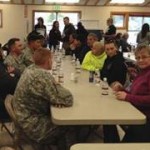

A visit to hurricane-battered Louisiana inspired prompt digital planning after the SR 530 Slide that will sustain communications needs for the long haul.
EVERETT, Wash. – A visit to hurricane-battered Louisiana in October 2013 gave seven members of the state of Washington’s Coalition of Recovery Planners a first-hand look at extensive long-term recovery projects taking place. At the time, at least one member of the tour group, Snohomish County Planning and Development Services Director Clay White, had no idea how quickly he would need to tap into his newly acquired knowledge. Then, the State Route 530 Slide happened in Oso.  Everett, Wash. — June 10, 2014 – Members of the Snohomish County Planning and Development Services, Planning and Technology Division, discuss their part in a larger public outreach and communications effort accomplished by Snohomish County officials after the SR 530 Slide. Immediately after the slide, Office Supervisor Lori Lollis, (left); Planner Eileen Canola, (middle) and Associate Planner Christina Ghan (right) quickly set to work organizing digital communications for Planning and Development Services that will help support long-term recovery. Photo courtesy of Snohomish County Planning and Development Services
Everett, Wash. — June 10, 2014 – Members of the Snohomish County Planning and Development Services, Planning and Technology Division, discuss their part in a larger public outreach and communications effort accomplished by Snohomish County officials after the SR 530 Slide. Immediately after the slide, Office Supervisor Lori Lollis, (left); Planner Eileen Canola, (middle) and Associate Planner Christina Ghan (right) quickly set to work organizing digital communications for Planning and Development Services that will help support long-term recovery. Photo courtesy of Snohomish County Planning and Development Services
“When I went to Louisiana, I never knew I would need this information,” White said, “but then, a few months later, the SR 530 Slide happened.”
Rather than responding by going directly to the site of the slide, White gathered staff with Snohomish County Planning and Development Services at their office in Everett. Among other things, they started organizing a digital information portal to help streamline digital communications for Planning and Development Services needs.
Within four days after the slide, the team established a Web page on the Snohomish County site that addressed the influx of public records inquiries they were receiving while filing digital information in one spot that would provide access to the public for the long term.
The informational Web page includes maps showing where building permits were issued in relation to the slide, as well as key facts and important dates that will remain available to the public in the future. The Web page is just one piece in the digital communications efforts accomplished by many groups and officials with Snohomish County after the SR 530 Slide.
“The building and land use documents that we gathered and posted provide a glimpse into historical decisions and processes that can help inform future policy decisions,” said Planner Eileen Canola.
The team’s digital communications planning was just one example of how long-term recovery has been a priority – even since the very first hours after the slide. The team also worked together to create an organizational chart related to responsibilities for assignments. They made sure departmental responsibilities were covered and then started assigning tasks. Together, they developed a strategy for going forward.
“Looking back, I think the training Clay received in St. John the Baptist Parish during his visit to Louisiana really helped,” said Barb Mock, a division manager with Snohomish County Planning and Development Services. “First, immediately after the slide, he remained calm, called a select team to a conference room and, even though we had numerous meetings that day, he added one first thing in the morning, one at lunch, and one at the end of the day. He had learned that communications and chain of command and roles and responsibilities are important.”
The trip to Louisiana was a collaborative effort between the state of Washington; the Federal Emergency Management Agency’s (FEMA) National Disaster Recovery Support (NDRS) group; the State of Louisiana Office of Community Development; and representatives from St. John the Baptist and Terrebonne parishes.
During the tour, seven emergency managers from Washington listened in on long-term recovery teams as they collaborated and discussed funding proposals and other important planning aspects.
“To see officials working together so well allowed us to see how the community had faced adversity and how they could come out on the other side,” White said.
White and the others who visited Louisiana long-term recovery groups soon realized that, while long-term recovery begins immediately after a disaster, the process continues for years to come.
“While dealing with today, focus on what you’re going to be doing in a few months,” White said. “The visit to Louisiana helped me understand how the long-term response is just as important as the initial response. There is a need to think ahead, to prioritize the recovery. There is recovery, and then there is something called long-term recovery.”
See the original article here –
After the SR 530 slide: long-term recovery in the Evergreen state




